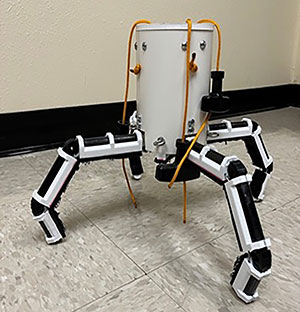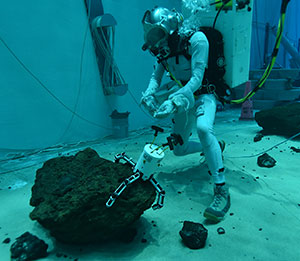
Contact Us
Institutional Communications
Bureau of Mines Building, Room 137
Laramie, WY 82071
Phone: (307) 766-2929
Email: cbaldwin@uwyo.edu
UW Student Team First From Wyoming to Participate in NASA Design Challenge
Published August 05, 2022

Five UW undergraduate students, dubbed the Wyoming Space Wranglers, designed and built
the Cowboy Claw, a lunar reusable surface anchoring device. The team of engineering
students was the first from Wyoming to be selected and participate in NASA’s 2022
Micro-g Neutral Buoyancy Experiment Design Teams (NExT) engineering design challenge.
(Wyoming Space Wranglers Photo)
A team of University of Wyoming students was the first from Wyoming to be selected and participate in NASA’s 2022 Micro-g Neutral Buoyancy Experiment Design Teams (NExT) engineering design challenge.
Five undergraduate students in the UW College of Engineering and Physical Sciences, dubbed the Wyoming Space Wranglers, designed and built the Cowboy Claw, a lunar reusable surface anchoring device. Team members were Cameron Ball, from Colorado Springs, Colo.; Forrest Bucholz, of Alpine; Reese Romero, from Cody; James Sheets, of Powell; and Daniel Wenger, from Vale, Ore.
“We were ecstatic to hear that we had been accepted to the Micro-g NExT challenge,” says Sheets, who graduated this spring. “After several months of deliberation, NASA released the accepted teams in the form of an acceptance video. We were very happy to hear our name called. We were selected alongside other large schools in the nation, who had teams much larger than ours.”
Micro-g NExT encourages undergraduate students to design, build and test a tool or device that addresses an authentic, current space exploration challenge. The experience includes hands-on engineering design, test operations and public outreach. Micro-g NExT provides a unique opportunity for students to contribute to NASA’s missions, as the design challenges are identified by NASA engineers as necessary in space exploration missions.
“The challenge provided an opportunity to invent something new,” Sheets says. “It was really a great opportunity to tinker.”
Wenger says his favorite part of the experience was rapid prototyping and testing.
“It’s one thing to spend a lot of time designing a project on paper and building it once, but we had the chance to try lots of different ideas and test new parts every day,” he says. “I think we were able to use a lot of creativity.”
This year’s challenges focused on the lunar surface extravehicular activity (EVA) operations of Artemis, NASA’s lunar exploration program. The three challenges involved designing an EVA sample size location calibration marker; an EVA sample bag and dispenser; and a lunar reusable surface anchoring device.
The Wyoming Space Wranglers participated in the third challenge. The objective was to design and manufacture an anchoring mechanism that is able to provide holding force on a variety of objects with different types of surfaces.

A diver tests the Cowboy Claw in the NASA Johnson Space Center Neutral Buoyancy Laboratory.
(Micro-g NExT Photo)
“Our main inspirations for the design were the dexterity and versatility of the human hand,” Sheets says. “Inside the human hand, the knuckle joints are known as compliant mechanisms. They bend to accomplish a goal and then return to their original shape. We mimicked this by creating joints out of a 3D printed thermoplastic polyurethane that is available in the University of Wyoming Innovation Wyrkshop. These joints, in combination with stainless steel tendons, allowed for our device to maintain a strong grip on a variety of rocks. Our team used these two key aspects of the design to create a lightweight, reusable, durable and nonpenetrative device.”
The importance of an anchoring mechanism in space is mission critical.
“The Cowboy Claw is intended to allow astronauts to tether themselves, their gear or other EVA devices to the lunar surface,” Ball says. “A quickly established anchoring point enables astronauts to safely conduct their research. Additionally, anchoring devices, such as ours, can be applied to other manned or unmanned future space exploration efforts to Mars and beyond. Furthering mankind’s understanding of the lunar environment will help us understand our world better and help prepare us for future planets that await us.”
The Cowboy Claw was delivered to NASA’s Johnson Space Center in Houston at the end of May. Micro-g NExT coordinators and NASA personnel examined the UW team’s device as well as the other selected teams’ devices.
“We felt a combination of excitement, stress and nervousness through the challenge process,” Sheets says. “The timeline for the development of this device was extremely fast, so we had to rapidly manufacture the device and quickly test it. This led to a lot of worries about if our idea would work or not. It ended up exceeding our expectations.”
In June, the UW team participated in a test readiness review before traveling to Houston to have its project tested by professional divers in the NASA Johnson Space Center Neutral Buoyancy Laboratory (NBL), a simulated microgravity environment.
“It was a lot of fun to watch the divers test our device in the NBL, and the testing experience felt very authentic,” Sheets says. “Our device first had to pass through a safety check to ensure nobody got hurt. Then, we were able to brief the diver with some instructions before use.”
When it came time for the Cowboy Claw to be tested, the Wyoming Space Wranglers were allowed to sit in a control room and supervise the test.
“One of our team members was allowed to communicate with the diver over radio to provide instructions, and all of this was broadcast to the rest of the schools at the NBL,” Sheets says. “Perhaps the most fun was watching how devices from other schools performed. Some schools had some designs that were fairly similar to ours, and other teams went in entirely different directions. Of course, we were excited to see the Cowboy Claw hold its own against devices from large and well-known institutions.”
Ball, who graduated in May, will begin his career with Lockheed Martin in Colorado, where he will work in the company’s space division. He says he would like to see other UW students be part of the Micro-g NExT experience.
“I hope that future UW senior design teams or students in some kind of a ‘NASA challenges club’ follow in our footsteps,” Ball says.
To learn more about the NASA Micro-g NExT challenge, visit https://microgravityuniversity.jsc.nasa.gov/about-micro-g-next.
Contact Us
Institutional Communications
Bureau of Mines Building, Room 137
Laramie, WY 82071
Phone: (307) 766-2929
Email: cbaldwin@uwyo.edu
